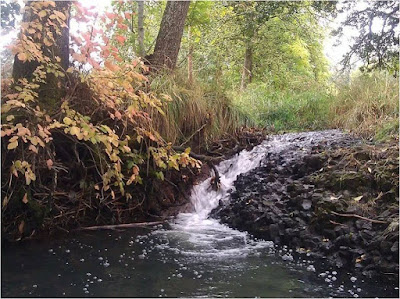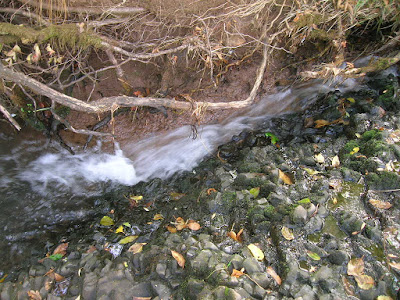The other day some of the Parks sites shared a photo from Clark Creek Park. There's a tiny little falls and pool there that shows a distinct seam between two geological layers.
 |
| Clark Creek at Clark Creek Park - Rigo Macio via City of Salem Parks Volunteers |
 |
| Close up showing reddish Jory soil and chunky, basalty rock |
Does anyone know anything about this tidbit of local geology? Is that chunky rock the characteristic bedrock around here? Or is this an intrusion over some other more characteristic layer?
 |
| The New Minto Park Master Plan has a map of soils (detail) |
Ever so slightly related, the New York Review of Books has an amazing set of articles (and one interview) up right now. One is on Alexander von Humboldt, who definitely doesn't get enough attention these days, and may be a surprising resource as we think about the challenges of climate change.
More plants, animals, minerals, and places are named after Alexander von Humboldt than anyone else. http://t.co/qJG7OS9YLX
— NY Review of Books (@nybooks) October 13, 2015
From the piece:Humboldt’s most consequential findings, however, derived from his conception of the world as a single unified organism. “Everything,” he said, “is interaction and reciprocal.” It seems commonplace today to speak of “the web of life,” but the concept was Humboldt’s invention. Into the seventeenth and eighteenth centuries, thinkers like René Descartes, Francis Bacon, and Carl Linnaeus were still echoing Aristotle’s view that “nature has made all things specifically for the sake of man.”
Particularly heterodox was the implication that the decline of one species might have cascading effects on others. The possibility that animal life might not be inexhaustible had been proposed by the German anatomist J.F. Blumenbach (who taught Humboldt at the University of Göttingen), but was not widely accepted. “Such is the œconomy of nature, that no instance can be produced of her having permitted any one race of her animals to become extinct,” declared Thomas Jefferson in 1784, an opinion shared by most naturalists. Convinced to the end of his life that mastodons still existed in North America, most likely in the “unexplored and undisturbed” regions of the continent, Jefferson urged Lewis and Clark to look for them during their expedition.


3 comments:
Didn't you hear? The Chamber is going to solve our transit funding problem! Big news!
https://salemchamber.org/blog/2015/10/13/salem-chamber-initiates-legislative-effort-to-fund-transit/
some of your followers might like this video by "Adam Ruins Everything" on TruTV
http://www.autoevolution.com/news/adam-ruins-everything-shows-why-car-dealerships-are-evil-makes-us-praise-tesla-video-100929.html
it is about auto-ism and its costs and why we are the prey of the car dealerships
Here we go. On the Eyrie Vineyards website, they say:
"Jory and the closely related Nekia soils were deposited as volcanic flows 15 to 17 million years ago. Over time, the surface of the basalt mother-rock decomposed into a red soil overlaying a deep layer of rounded and eroded basalt cobble. This combination gives Jory and Nekia soils special properties that are ideal for dry-farmed vines. The soil structure allows the constant winter rains of the valley to drain readily. However, in Oregon’s very dry summers, the underground cobbles retain enough water in their cracks and crevices to support the vines without the need for irrigation."
The seam at the "falls" looks exactly like the transition between red Jory soil and that "basalt cobble."
Post a Comment